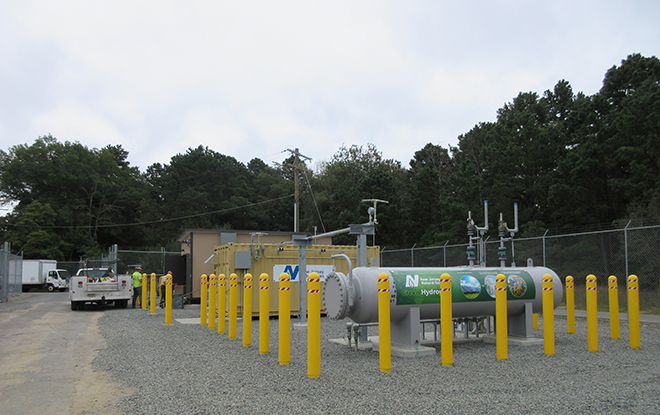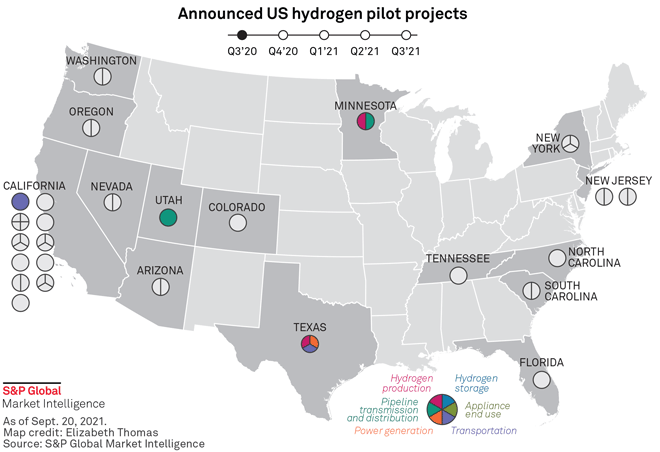S&P Global Offerings
Featured Topics
Featured Products
Events
S&P Global Offerings
Featured Topics
Featured Products
Events
S&P Global Offerings
Featured Topics
Featured Products
Events
Banking & Capital Markets
Economy & Finance
Energy Transition & Sustainability
Technology & Innovation
Podcasts & Newsletters
Banking & Capital Markets
Economy & Finance
Energy Transition & Sustainability
Technology & Innovation
Podcasts & Newsletters
S&P Global Offerings
Featured Topics
Featured Products
Events
10 Nov, 2021

|
New Jersey Resources Corp.'s hydrogen pilot in Howell, N.J., is small in scale but positions the company to gain expertise in project development and pipeline blending as regional hydrogen economies emerge, according to the company. |
New Jersey Resources Corp., or NJR, has placed its green hydrogen pilot project into service, making the gas utility operator the first on the East Coast to blend the zero-carbon fuel into its distribution system.
The project went into operation at NJR's Howell, N.J., training facility in October and has since been delivering small amounts of green hydrogen to homes and businesses within subsidiary New Jersey Natural Gas Co.'s service territory. The startup gives NJR a pole position among roughly a dozen gas utility operators that have announced hydrogen pilot projects, as the industry seeks to demonstrate that gas infrastructure can play a role in mitigating climate change.
"We believe using the existing infrastructure to deliver decarbonized fuels is going to get us to emissions reductions more quickly," NJR President and CEO Stephen Westhoven said in an interview. "We're going to maintain reliability, and we're going to be able to do it cheaper than if you just pick one path forward alone."
At the heart of the project is a 175-kW electrolyzer produced by Norwegian hydrogen equipment manufacturer Nel ASA. The unit produces 65 kilograms per day of hydrogen, which NJR injects into an 8-inch, 60-pounds-per-square-inch distribution line. NJR currently uses renewable electricity from wind resources to power the electrolyzer, which splits water into oxygen and hydrogen. It will eventually source electric power from a 414-kW on-site solar array.
NJR seeks to gain expertise, change conversation
To start, NJR is flowing a less than 1% blend of hydrogen into the gas grid. Like many of its peers, Westhoven said NJR is seeking to develop expertise in hydrogen project development and pipeline blending in anticipation of broader deployment, which has generated support among lawmakers in Washington, D.C., and NJR's home state.
New Jersey legislators are considering a bill that would allow cost recovery for renewable gas investment and procurement. At the federal level, the Biden administration launched a program to drive down the cost of low-carbon hydrogen by 2030, while congressional Democrats are advancing a hydrogen production tax credit.

Westhoven also sees hydrogen as a pathway to align NJR's business with New Jersey's Energy Master Plan. While that plan called for maximum electrification of the building and transportation sectors, Westhoven stressed that it also prioritizes clean energy innovation.
By demonstrating hydrogen blending, NJR aims to illustrate the potential to use existing infrastructure to decarbonize gas delivery, Westhoven said. As the technology becomes more widely understood and stakeholders get more information about costs and the potential pace of deployment, Westhoven believes that restrictions on new gas hookups will become less central to the decarbonization debate, and gas utilities will get a seat at the table.
"The most important part of this was just to kind of prove to the outside world this isn't just a theory in New Jersey," Westhoven said. "This is something you can put into practice. This is something now you can scale."
Hydrogen would leverage existing infrastructure, balance grid
In New Jersey, 75% of residents consume natural gas in their homes through connections to 35,000 miles of distribution infrastructure, according to NJR. New Jersey Natural Gas alone has invested $2.3 billion over the past decade to upgrade its infrastructure. Nearly the entire system now consists of plastic or protected steel pipe, positioning the utility to begin flowing hydrogen, which can compromise some steel grades.
Hydrogen blending would also provide valuable grid balancing services as New Jersey aims to build out solar and wind power projects, Westhoven said. By using excess zero-carbon electric power during low-demand periods to produce hydrogen, the fuel essentially functions as an energy storage mechanism.
New Jersey aims to develop 7,500 MW of offshore wind resources by 2035, and NJR expects a significant amount to come online in its service territory, enabling interconnections with hydrogen production facilities. Fellow Garden State gas distributor South Jersey Industries Inc. has announced a pilot project to produce green hydrogen from electricity produced at wind farms off the Jersey Shore.
NJR's investments in solar power also align with the hydrogen opportunity, Westhoven said. NJR is the largest owner and operator of solar power in New Jersey and expects to develop renewable natural gas resources, derived from methane waste sources like landfills and food waste facilities.
"I think putting all those things together, it just makes so much sense to continue to use a high-quality asset that's below the ground, is extremely reliable when compared to the electric grid," Westhoven said. "I think this is a case where having both systems together can actually facilitate an emissions reduction in the future."
